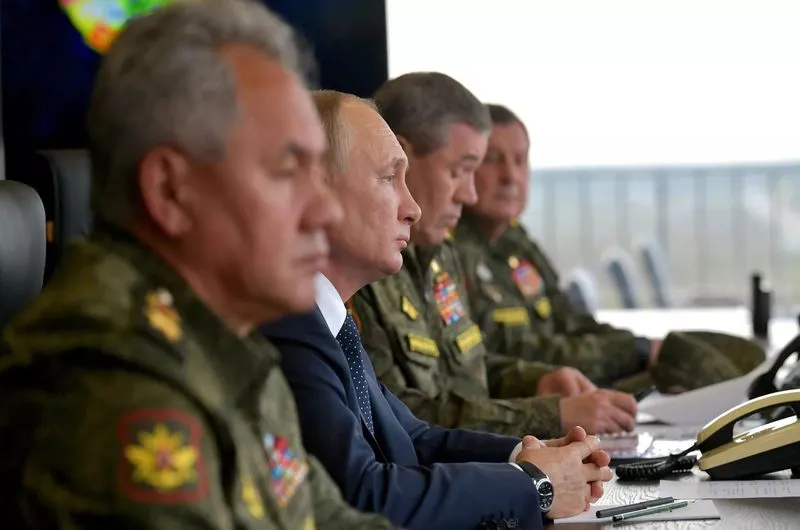
Russia’s lies about NATO are well-known. Less known are the real security concerns behind them. Hans Petter Midttun explains:
“Russia is not facing a military threat, but the ‘threat of democracy.’ Free nations are based on universal rights, democratic principles, and common values. All of which is in direct conflict with the Russian world and its authoritarian rule. It is this — or the possibility that the Russians will want the same — that threatens the Russian elite“.
Russia is waging a hybrid war in the cognitive sphere to confuse and manipulate. It tries to impose its will on us using military force, threats, energy, migration, corruption, and, not least, disinformation. It seeks to create a virtual reality that motivates nations to make decisions that serve Russia.
The ambiguity that arises at the interface between threats of military escalation and the hope of a peaceful solution is exploited to complicate our decision-making processes. Disinformation contributes to the difficulty of both political and military response.
The list of Russian disinformation is long, Very long. While nearly 40% of all the cases in the EUvsDisinfo database are about Ukraine, very many are about NATO. The biggest disinformation of all horrendous claims is the allegation that NATO threatens Russian security. The fact that Russia is making the claim does, however, not make it a truth. On the contrary, a nation that uses information as a weapon can also lie about the threat.
The ultimate lie
The realities undermine the claim.
Facts 1. NATO is not an aggressor.
It is the defensive alliance of 30 democratic nations. Any decision on military action requires consensus. Where the alliance is arguing for a common strategy to ensure collective defense, it is impossible to imagine that the countries will consider attacking a nuclear power.
Facts 2. The West does not have hostile intentions towards Russia.
Dmitry Nekrasov recently dissected the Kremlin’s “myths” about the West’s hostile intentions. He pointed out that Russia has never been attacked by NATO, not even when it was weak. On the contrary, “during the period of Russian weakness, the efforts of the West (albeit not as vigorous as they could be) were [ ] aimed at preventing chaos, stabilizing, transferring the entire nuclear potential to the Russian Federation, loans, humanitarian aid, etc.”. Even during the Cold War, the alliance focused on containment. An attack on the Soviet Union was never considered.
NATO did its best to ensure that Russia did not disintegrate after the collapse of the Soviet Union. In 1991, NATO’s security challenges were linked to the “adverse consequences of instabilities that may arise from the serious economic, social and political difficulties, including ethnic rivalries and territorial disputes”, as well as the risk of proliferation of weapons of mass destruction.
Facts 3. Russia has no reason to feel insecure: it is already protected by one of the most powerful armies in the world.
In an open letter to the German government, around 70 German experts on Eastern European Security argued that “more nuclear warheads are stored in Russia than in the three NATO nuclear-weapon states USA, Great Britain, and France put together. Moscow maintains a wide range of delivery systems for its thousands of nuclear weapons – from ICBMs to long-range bombers to nuclear submarines. It has one of the three most powerful conventional armies in the world and a right of veto in the UN Security Council. This makes the Russian Federation one of the militarily safest countries in the world.”
The Russian Armed Forces can deter all possible (and unlikely) opponents, so any arguments that Russia faces a military threat from the West are unfounded.
Facts 4. Russia is an aggressor, not a victim.
According to the former Polish Foreign Minister, Radek Sikorski, Russia has long portrayed itself as an “eternal victim of aggression”, whether by Napoleon, Hitler, or the democratic West.” But the reality is that Russia started as a small principality and has grown to become the largest state in the world by occupying more and more land from its neighbors. Russia is not a victim. It is an aggressor.
For an objective and balanced description of what happened in Eastern Europe just before, during, and after World War II, Timothy Snyder’s book “Bloodlands: Europe Between Hitler and Stalin” is mandatory. The book deals with the countries that were fully occupied by Nazi Germany (and later the Soviet Union), namely Poland, Estonia, Lithuania, Latvia, Belarus, and Ukraine. For a closer look at Ukraine, the presentation the renowned historian held at the German parliament in June 2017 under the title “Germany’s Historical Responsibility for Ukraine” is a must.
Germany’s historical responsibility towards Ukraine discussed in Bundestag
On 19 May 2017, Germany’s Green party initiated debates on the topic of Germany’s historical responsibility towards Ukraine. The party prepared a draft resolution in support of Ukraine, which was submitted to the foreign affairs committee of the Bundestag. The discussion was initiated due to the reinterpretation of Germany’s historical responsibility for Nazi crimes as such … Continue reading
If one projects the furthest easternmost reach of Nazi Germany (eastern front) on today’s Europe, one will find that less than 5% of Russia was occupied. In contrast to the “eternal victim of aggression,” all of Poland, Estonia, Lithuania, Latvia, Belarus, and Ukraine remained occupied until the collapse of the Soviet Union.
Putin’s former adviser and the ideologist behind “Putinism,” Vladislav Surkov, recently stated that constant expansion is at the heart of Russia’s historical nature and argued that it would continue to expand. Its ongoing attempt to expand at the expense of Moldova, Georgia, Ukraine, and Belarus proves his statement accurate.
Facts 5. NATO does not encircle Russia.
Of its land border of just over 20,000 kilometers, less than 6% is shared with NATO members. Russia borders 14 countries, of which only 5 are NATO members.
Facts 6. NATO enlargement does not threaten Russia.
The claim that NATO enlargement threatens Russia’s security is only rational in the context of disinformation and manipulation.
Since the collapse of the Soviet Union, 14 nations have freely chosen to join the Alliance. More are hoping for or considering future membership. Their choice has, in part, been motivated by their fear of Russia. NATO enlargement is only a consequence of their choice.
The claim that their security arrangement threatens Russian security is, therefore, utterly nonsense. Especially because NATO is a defensive alliance whose purpose is to protect its member states. The point is underscored by the fact that Russia’s nuclear weapons and conventional forces guarantee its security.
Facts 7. It is Europe’s and NATO’s security is threatened, not Russia’s.
Russia has spread many myths about NATO. This includes claims that the alliance’s presence in the Baltic countries is a danger and that NATO is both encircling and trying to contain Russia. Not least, it claims that NATO is aggressive and a threat and that its enlargements threaten the country’s security. All have been debunked by NATO.
Russia has repeatedly turned away from international agreements that reject its right to change borders by force, impose on other nations their will, and deny other countries the right to choose governance, security arrangements, or alliances. By waging war and imposing its sphere of influence on its neighbors, Russia is acting in breach of the international security architecture that has laid the foundation for our common security.
Antony J. Blinken pointed out the absurdity of the claim that NATO is a problem. ” NATO didn’t invade Georgia; NATO didn’t invade Ukraine. Russia did.” In 1997, NATO promised to significantly reduce its military forces. And NATO did just that. Russia promised the same but chose instead to invade two countries.
The list of Russian aggressions includes not only its use of military force but also coup attempts, interference in elections and referendums, disinformation, cyber-attacks, terrorist attacks, liquidations, restrictions on freedom of navigation, and more. The EU stated in September that Russia is trying to destabilize the union from within and concluded that the current Russian regime threatens European peace and security.
The country considers itself entitled to a sphere of interest. It demands a change in the international security architecture at the expense of smaller nations. It requires that NATO’s presence and pattern of operations throughout Eastern, Central, and Northern Europe be reduced at the expense of the countries’ security needs. Not least, Russia seeks to weaken transatlantic cooperation, which has ensured our collective security for more than 75 years.
